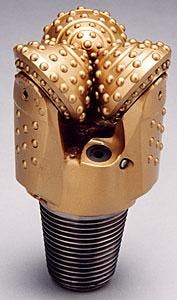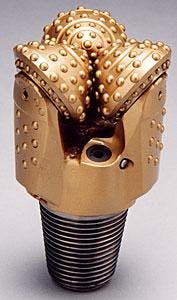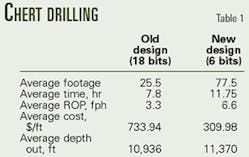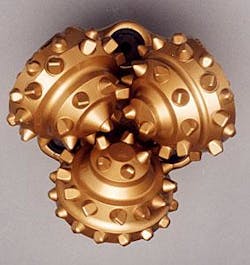Two examples, one in a hard-rock, slimhole horizontal and the other in a North Texas vertical well, show how custom-designed drilling bits can lower costs and improve drilling performance.
In both of these cases, the operators realized substantial cost-per-foot savings after a thorough analysis of formation characteristics and bit performance and drilling with custom bits for specific applications.
Hard rock slimhole horizontal
Burlington Resources Inc. in a Lea County, NM, 43/4-in. slimhole horizontal had a high incidence of bit failure in a section that was 70-90% chert, a higher than expected concentration.
null
Total vertical depth of the well was more than 11,000 ft.
After several bit failures, Burlington contacted RBI-Gearhart for a solution. Its directional specialist evaluated the dull bits and reviewed the failure modes, noting that the gage-row area reflected insert breakage as the primary failure mode with the inner-row, flat-crested wear being a secondary concern.
If the gage held up, then the inner-row wear allowed the bit to core out, thus leading to a potential catastrophic failure.
The required solution for eliminating the breakage in the gage-row involved a simple modification that changed the insert carbide grade and increased the insert count. For the inner row, the modification involved changing the insert carbide grade to a harder, more- abrasive, resistant material and increasing the insert count in the nose to stop the potential core out.
The recommended bits were a modified Excalibur 43/4 in. 7-3-7, C7 LRGSP and an Excalibur 43/4 in. 8-1-7, C8 LRGSP (Fig. 1).
RBI-Gearhart provided the modified bits in 72 hr, and the new design was on bottom within 6 days.
Drilling the chert section required 24 bits. The six custom designed bits drilled more than 40% of the formation, doubling the rate of penetration for this section.
The customized bit designed for this specific application enabled this section to be drilled cost effectively (Table 1).
North Texas vertical
During the past 2 decades, the industry has made tremendous improvements in both the rate of penetration and bit life for routine applications. A rapidly designed custom bit, however, can improve drilling efficiency even in routine wells.
A new bit design helped Devon Corp. improve the economics and efficiency of drilling a formation consisting of sand-shale with chert stringers in Wise and Denton counties in North Texas.
Development wells in the area, drilled over 20 years, had slight variations in depth but overall were similar.
RBI-Gearhart selected a 77/8 in. vertical well with a depth of 7,100 ft for its study on new bit designs for the area.
The study used a single rig to eliminate variations such as different pumps, motors, hydraulics, and personnel.
A specific bit type gave the best overall performance for the top, middle, and bottom sections of the well. From a review of the drilling history, RBI-Gearhart believed the drilling required three very different bit types to effectively penetrate these sections.
Often drilling engineers find it difficult to change bits significantly in 77/8 in. shallow vertical wells because of economics and proven parameters from previously drilled wells.
Most 77/8 in. well designs traditionally have only two casing strings. The first is the surface pipe, which normally is less than 2,500 ft, and the second section is the 77/8 in. pipe to TD.
These wells are seldom more than 8,000 ft deep. Economically, the casing and bit are the lowest cost items.
The specific energy load on the 77/8 in. drill bit is much greater than on other diameter drill bits. The higher load factors normally lead to faster drilling and the shallow well profiles keep the mud cost at a minimum.
This overall penetration rate is helped by the water or very light weight mud used to drill most of the hole to TD.
The study used data from 14 previously drilled wells for the selected rig. The averaged parameters set the standard. It also divided each well into three sections.
The same rig drilled four more wells with the new bit designs.
The first well using three off-the-shelf bit designs achieved the average bit performance of the previous 14 wells. After reviewing the dull bits, RBI-Gearhart designed and manufactured a new bit for the first bit run on the second well.
The new bit lowered by 20% the cost-per-foot for the upper section.
The second well, however, indicated that the No. 2 bit run required the most attention. RBI-Gearhart, therefore, selected another bit design for the intermediate section of the third well.
null
In a chisel-type bit with vectored inserts, the manufacturing involves calculating the inboard and radial movements and pressing the inserts into the cone at a skew that is relative to the angle of incidence at which the inserts engage the formation. This evenly distributes the load against the crest of a chisel-shaped insert.
RBI-Gearhart has found this design to be effective in formations with hard imbedded stringers. These formations normally create severe problems that keep more aggressive bits from being effectively utilized.
This 7.875-in. vectored bit lowered the cost and improved the ROP for drilling routine wells in North Texas (Fig. 2).
The vectored inserts allow an aggressive bit to perform and last through these hard stringers, resulting in better overall performance.
Three bits drilled most of the previous 14 wells. The approach used fewer bits but drilled slower with tougher bit designs.
The new program reduced the cost-per-foot and cost-per-well by using two formation specific bits and a third bit with a slightly modified design (Tables 2 and 3).
The new bit designs, on the fourth well, surpassed the $7.00/ft average target. Its cost of $6.97/ft was lower than the $9.69/ft cost of the original 14 wells and reduced the total well cost by $20,386.
This design comparison and project completion took only 45 days from request to solution.
The author
Jack Castle ([email protected]) is chief oprating officer at RBI-Gearhart, Fort Worth. He has been with the company for over 22 years and has been involved in design, manufacturing and sales during his career. Castle is a co-inventor with RBI engineers on several patents and is a member of various organizations including SPE, Society of Manufacturing Engineers, and Fort Worth.Wildcatters.







